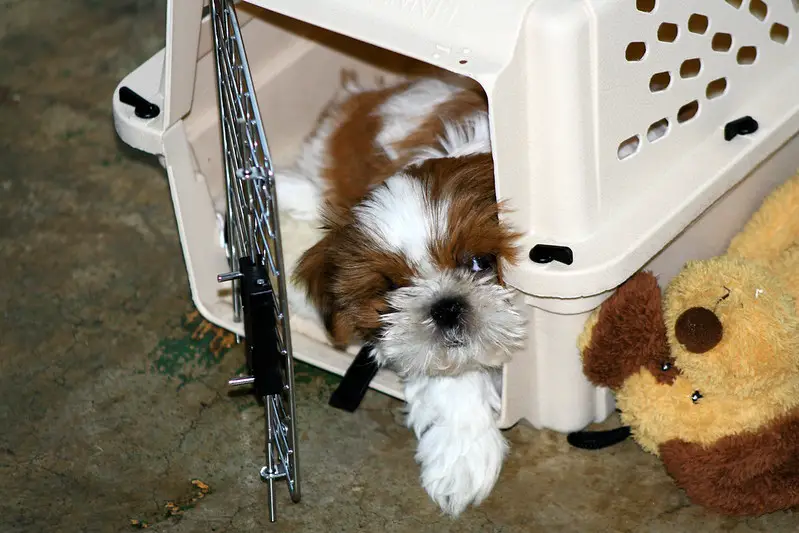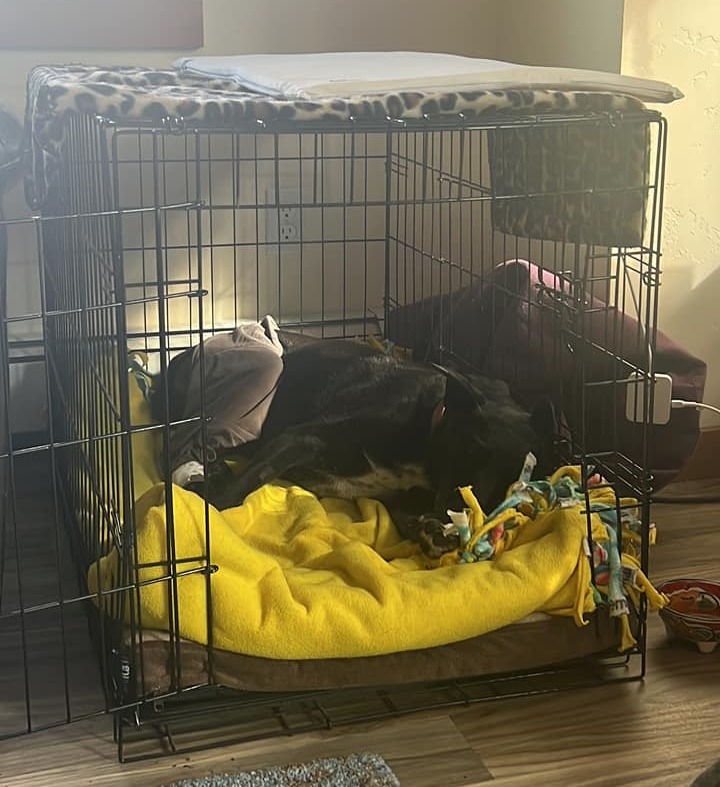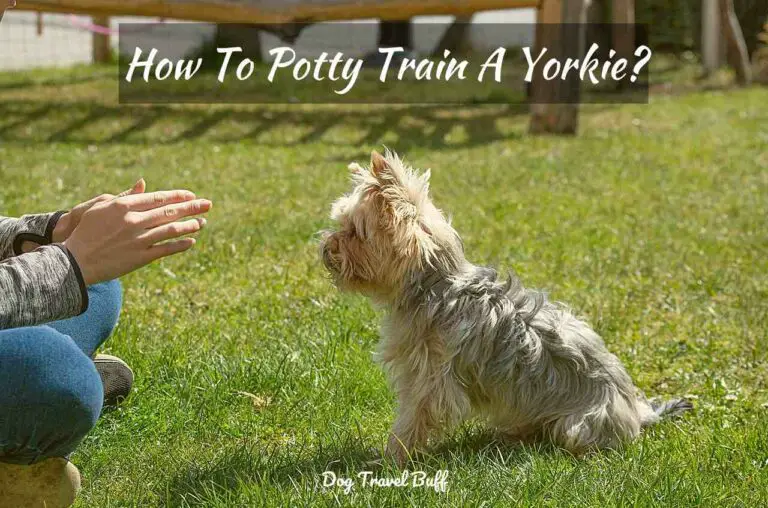Why Does My Dog Sleeps In Crate With Door Open: Is It Safe?
A crate functions as a haven for dogs. Pet owners often do not understand this behavior and ask why their dog sleeps in the crate with the door open. If you or someone you know has a dog at home, then we have all the answers for you related to a canine’s crate-sleeping habits.
Generally, there are benefits to open-door crate sleeping for dogs, and a proper night-time routine will help your dogs reap these benefits. So, with the right crate, you can make sure that your dog has a good nappy time.

This post may contain affiliate links. If you buy something through one of those links, you won’t pay any extra penny, but I’ll get a small commission that encourages me to deliver more helpful content for you.
Table of Contents
Benefits of Open-Door Crate Sleeping
Canine sleeping habits vary from one dog to the other. However, one factor that remains common is that an open crate sleeping routine has been beneficial to the physical and psychological health of many dogs. Here is how an open crate provides comfort to your dog friend.
1. Your dog gets it’s own Private Space
Every dog has their cozy nook where they would like to retreat. With the right comfy crate, your pet will get a private place all to his own. So, if they are feeling exhausted, sick, or just want to chill, they can always have the option of finding their way back to the doggy crate. Imagine it as your dog’s safe sleeping space, which will provide them with a sense of security.
2. Your dog will trust you more
Since the crate doors are always open, your dog will never feel that he is enclosed in a prison. Sleeping with the crate door ajar will also let him come in and out whenever he feels like it. This will allow him to trust you and feel that you are not holding him down by forcing him to be inside a crate all the time.
3. Your dog will receive proper potty training
No dog would like to soil the area where they sleep. This will instinctively make him realize that he cannot pee or poop within certain spaces. Hence, potty training will become far more convenient and achievable.
4. You can keep your dog safe during any situation
Once your dog gets habituated to his crate left open, you can also, at times, close the crate door whenever the situation requires you to do so. For instance, sharp objects are lying on your floor, and you need your doggy not to come anywhere near.
With the right crate training, you will be able to close the crate door and keep the dog safe without him crying or throwing tantrums because his instincts will be able to identify that place as a safe space.
5. Your Dog Will Get Well Adapted To Any Changes
Think that you are shifting to a new home. This big change can be stressful to both you and your dog. However, if you have a crate with you, your dog will identify it as its home and can retreat inside it whenever it feels stressed. The crate will eventually become a companion to your dog and a source of comfort. Hence, adjusting to changes will become much more solvable.

Preparing the Crate
Now that you know the benefits of letting your dog sleep in a crate with the door open, you must be wondering about how to decide the perfect crate and how you can make your dog feel comfortable within it.
A well-chosen crate can provide a safe and secure space for your furry friend, allowing them to relax and feel at ease. You’ll want to consider factors like size, material, and location when selecting the ideal crate.
Once you’ve chosen the right one, you can gradually introduce your puppy to it, making sure to create a positive association. With time and patience, your puppy is ready to sleep out of the crate, enjoying the sense of security and comfort it provides in your home.
Here are some tips you can follow:
1. Selecting the right crate size and type
Choosing the right crate size is the first step to a comfortable crate sleep. It should be spacious and airy and not feel like a prison. The right crate size will vary with each dog’s size, but all of them should be able to move and stretch their arms and legs comfortably.
It will also need to have an appropriate opening size so that your dog can easily escape from it and have good visibility. If the crate size is too small for your dog, it can feel claustrophobic to them and can hamper their sleep as well.
Secondly, the crate material should be made up of metal or plastic to ensure proper cleaning and sturdiness. It should also be of the right weight to carry the dog’s total weight and have functional, jam-free locks.
2. Adding comfortable bedding and essentials
A new sleeping place can be scary for many canines. You have to convert the crate into a familiar and friendly sleeping space. This isn’t very difficult to do as you can easily place your dog’s favorite toys or a chewing bone inside it. Such items will attract him instantly, and your dog will soon be loving his new home.
The other thing that owners should take care of is providing comfortable bedding and additional blankets. Sleeping on a warm and cozy rug is always better than lying on a hard surface, and the correct bedding will ensure that your dog is sleeping comfortably.
You can also decide between orthopedic padding or cotton padding, depending on your dog’s needs. Make sure the material is non-toxic and washed periodically during winters, you can provide some additional blankets to keep your dog warm in the cold.
3. Creating a den-like atmosphere
The last step of preparing a crate depends mostly on your dog itself as it gets habituated within it. It should be feeling like the den that your dog has been forever wanting. As we already suggested in the previous point, you need to add some toys and his chewing bone inside it.
You will be good to go with that, and you may even notice that your dog starts bringing and storing his toys and bits of food inside it. This will give you a good enough hint that he has now successfully converted it into a den. With time, he will also be able to associate a scent with the crate, and this will make him more likely to sleep in it.
Training and Transition
To reap all the benefits of crate training, you must begin with positive reinforcement training and help your dog transition from his previous sleeping habits to his new bedtime routine in the crate. Only with proper training will you be able to see results. Below, we have mentioned some common training methods that will help him transition:
1. Introduce the crate
Every new thing requires an introduction and a proper orientation. You cannot start by forcing your dog into the crate. Rather, be playful and generate excitement in him and then place the crate near him. If required, allow him to inspect it for a few days. Also, try placing small dummy toys within it so that your dog understands that it is a place where one can go inside.
2. Encourage your Dog to Step Inside
This is the time to use your bonding with your dog and motivate him to go inside. Use some familiar phrases and words and stand beside the crate. Try touching the crate to show him that it is safe. They will gradually enter and, once they do, utter some positive phrases that they are familiar with.
3. Use Positive Reinforcement
Doggy training requires a generous amount of positive reinforcement, and so is the case for crate training with an open door. Once they enter, you can reward them with treats so that they repeat their behavior till the point they start sleeping inside it.
4. Do not be Harsh on Your Dog
Remember that a crate is a big change for your dog, and it may be scary to him. Hence, in case you notice your dog refusing to enter or panicking all of a sudden, do not scold or punish him at all. This will only discourage him further.
While these were some training methods and tips, we have a word of caution for his transitioning time as well. It is important to understand that transitioning can be tough, and hence, you should always keep the door open during the initial days.
Also, make sure that you keep the crate at a place nearby so that it can always find you if it is stressed or anxious. We will talk about these concerns more in the coming parts.

Addressing Common Concerns
As we have already discussed, transitioning is a difficult phase. Even apart from that, your dog can exhibit concerning behavior later, too, especially when he is sick or stressed. Here are some things a pet owner should know:
1. Dealing with potential anxiety or stress in dogs
You may have heard many pet owners complain about their dog suddenly barking in the crate at night or crying in their sleep. These behaviors are signals that your canine may not be feeling comfortable in their new environment or could be experiencing fear.
While many dogs adjust well with a crate, some do not, and it is your duty to find the underlying cause. At most times, the reason is an improper crate size, uncomfortable bedding, or a health cause.
2. Preventing accidents and ensuring cleanliness
As a pet owner, you need to understand that crates can sometimes lead to unseen accidents. This happens mostly when crates are kept in a very high place or when sharp objects are lying inside them. Always place a crate on the floor and never at places like a staircase or a wide bookshelf.
Also, remember to check your crate every night and take any unwanted or harmful objects out of it that your dog could have carried inside. Lastly, your dog may accidentally pee or poop, and once you notice that, ensure that it is properly cleaned to prevent any infection or disease.
3. Balancing crate time with freedom
Buying a crate does not mean that you are going to cage your dog inside it at all times. A crate is only for sleeping and relaxation purposes and should be used accordingly. Your doggy should get enough freedom to be outside whenever he likes.
Even if there are times when dogs seem reluctant to come out of their crate, it’s important to encourage them to step out and play with you. Remember that getting daily exercise and social time is essential for dogs’ overall health.
So, if you’ve ever heard statements like ‘my dog wants to sleep with me even though it has a crate,’ you should allow it to do so at certain times, especially when your dog is fearful or simply wants to cuddle with you.
Nighttime Routine
Now that you know about pet crate comfort, you would be required to establish a healthy and daily nighttime routine for your dogs. The first step is to be consistent, and the second is to follow the nighttime crate training tips.
Establishing a consistent bedtime routine
If you are wondering why your dog is not getting habituated to the crate, it may be because you are still not consistently maintaining a bedtime routine. A routine is essential for anyone to get things in order, and so is your dog.
You should aim to have your dog go to sleep at the same time daily and take him to his crate so that he gets practiced with the routine. Once he identifies this daily pattern, he will have an easy time sleeping inside it.
Tips for a peaceful night’s sleep for both the dog and owner
These are some tips you can follow to let your dog and you have a good night’s sleep:
- Dim the lights every night once your dog has gone inside the crate.
- Use soundproof curtains so that unnecessary sounds don’t wake him up at night.
- Don’t give him excessive food and water before bedtime so that he does not feel the urge to pee or poop.
- Use a comfortable padding as well as an absorbing material for pee in case your dog urinates inside the crate.
- Place his favorite toy inside it so that he can find a source of comfort.
Safety and Monitoring
When we see a canine sleep with open crate door, we can be assured that it is safe. However, one still needs to be on their toes and stay alert to prevent any mishaps. Here is how you can do it:
Ensuring the safety of the dog while in the crate
As told earlier, the crate is supposed to be a safe space and not a dangerous or prison-like place. To do that, remove any harmful objects present inside it and choose a crate that is large and has a big space for air circulation. This will guarantee your dog’s overall safety.
Regular check-ins and adjustments
Checking the crate once your dog sleeps is also a necessary part of monitoring your dog. Don’t forget to replace the crate and adjust it to the dog’s size once he starts growing up and older.
Conclusion
In conclusion, nighttime crate training is advantageous for both dogs and their owners. However, the entire process relies on making informed decisions, assuming responsibility, and staying vigilant. Once a consistent routine is established, you and your dog will both be able to enjoy peaceful nights without worry.
FAQs:
1. Is it safe for my dog to sleep in a crate with the door open?
A: Yes, absolutely. It is safe to let your dog sleep in a crate with the door left open. This will provide him the assurance that he is free to enter in and out and is not tied down.
2. Will my dog feel anxious or stressed in an open crate?
A: Not necessarily, as an open crate is often more comforting. However, it’s common for dogs to experience stress and anxiety during the transition, but this typically improves over time.
3. What are the benefits of open-door crate sleeping for dogs?
A: There are several benefits to open-door crate sleeping for dogs. From feeling safe and secure to having their own private space, a crate offers numerous advantages. Additionally, with a crate, your dog will become potty-trained, protected from injuries, and help them adapt to changes such as moving to a new home.
4. How long should I allow my dog to sleep in an open crate each night?
A: Your dog should be sleeping inside a crate as long as his old sleeping duration was. Once he completes his dinner, he should be preparing to retreat into the crate and go to sleep. You can wake him up once the dawn breaks or at an appropriate time of your choice.
5. Are there any risks associated with open-door crate sleeping?
A: At times, yes, there can be some risks if you have rodents inside your house or your dog has a tendency to wander off.





